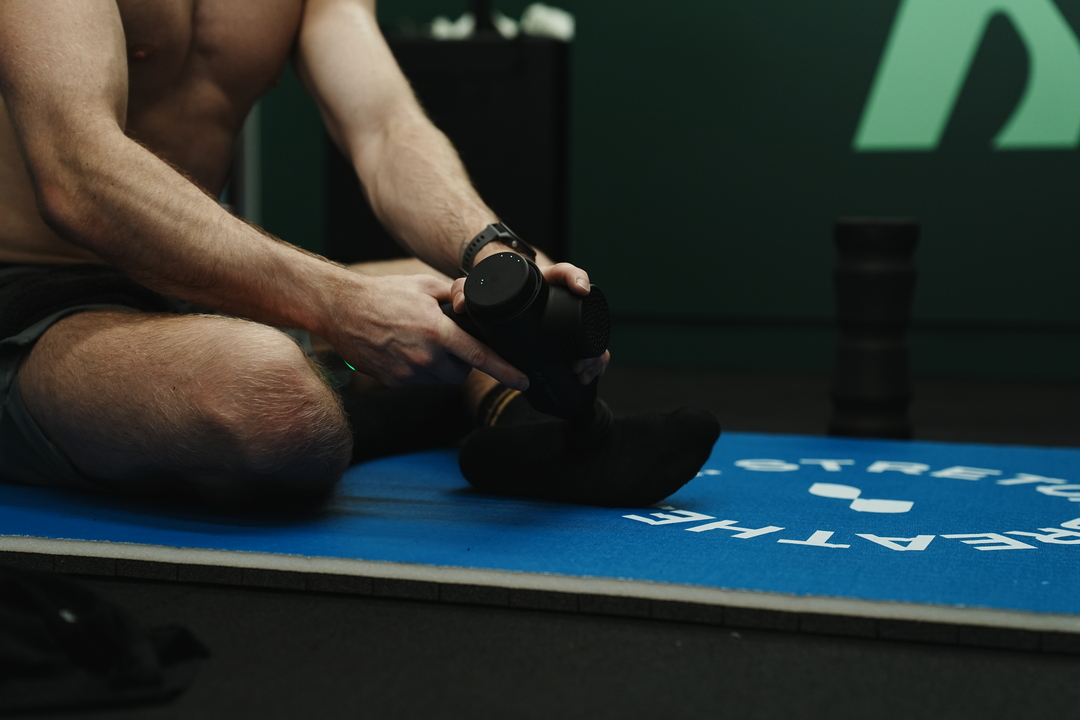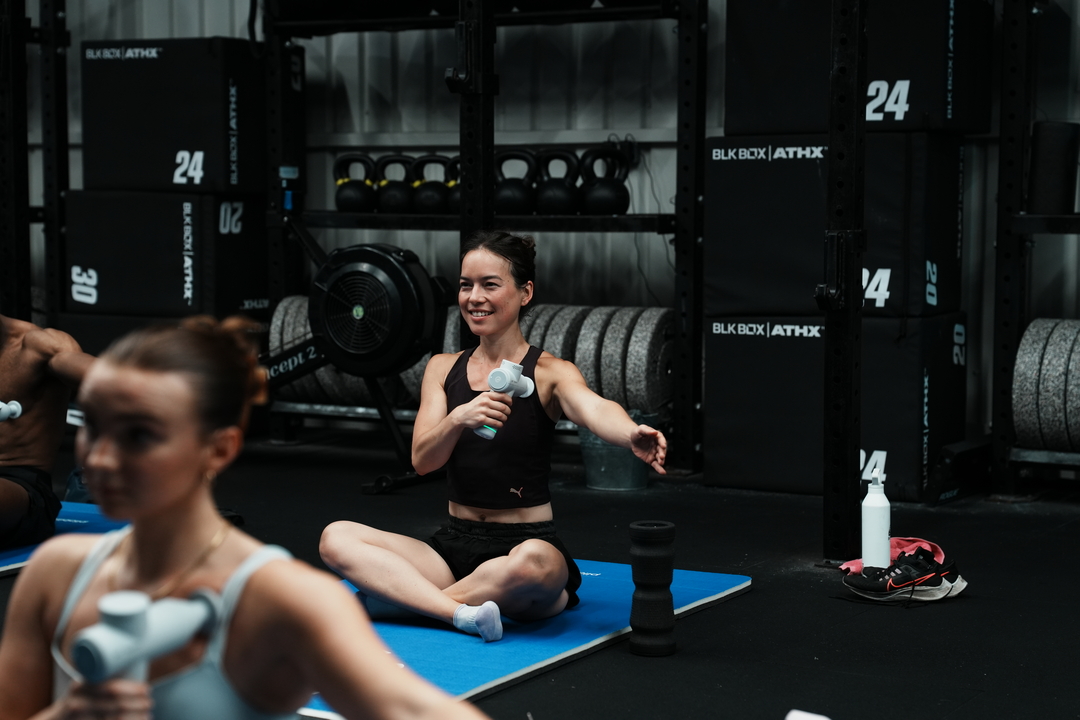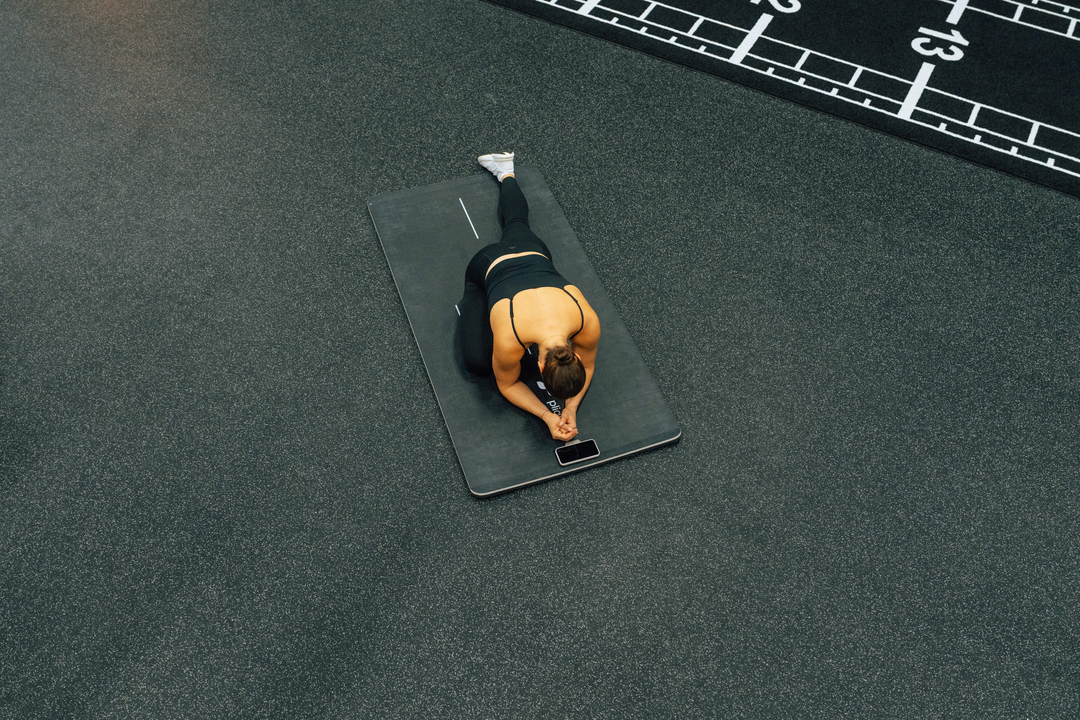Suppose you’ve ever felt a sharp ache or lingering soreness along the outside of your ankle after a run, a long walk, or a challenging workout. In that case, you might be brushing up against a problem called peroneal tendonitis. It’s one of those sneaky overuse injuries that can start small but quickly disrupt your training, your mobility, and even your confidence on your feet. With the right combination of strength, mobility, and smart prevention habits, you can protect your peroneal tendons, keep your ankles strong, and move with better balance and stability every day. In this guide, we’ll break down what peroneal tendonitis really is, what causes it, and most importantly how to prevent it before it sidelines your progress. Additionally, How to Recover Quickly From a Workout?
Pliability's mobility app brings these routines into your day with guided sessions, progress tracking, and gentle load management so you build resilience, prevent flare-ups, and keep moving with confidence.
Summary
- Peroneal tendonitis is primarily an overuse injury, with over 70% of cases caused by repetitive stress, making intentional load management the first line of prevention.
Conservative care is highly effective, with about 90% of patients recovering from peroneal tendonitis when provided with proper rest, graded rehabilitation, and progressive loading. - Surgical repair is necessary in a minority of cases, affecting approximately 15% of patients when mechanical subluxation or tears do not respond to documented conservative treatment.
- Targeted strength and balance work produces measurable gains, for example, resisted ankle eversion (3 sets of 12, twice weekly), single-leg calf raises (3 sets of 10 to 15), and dynamic balance drills across three sessions per week, typically applied in a consistent six-week block.
- Short, daily mobility habits prevent recurrence, such as a 1 to 3-minute pre-activity routine, five minutes of targeted mobility before sessions, and scheduling at least one full rest day per week to reduce cumulative tendon load.
- Training changes that reduce recurrence include programmed variety and conservative progression, such as swapping one high-impact session for cycling or pool work, and monitoring symptoms for 24 to 48 hours after each load increase.
- This is where Pliability's mobility app fits in; the mobility app addresses this by offering guided daily routines, a three-minute phone-based mobility check, and progress tracking to keep loading and mobility measurable.
What is Peroneal Tendonitis?

Peroneal tendonitis is the inflammation of the two tendons that run along the outside of your lower leg and wrap behind the outside ankle bone, usually caused by overuse or a sudden overload, such as an ankle sprain. You may experience pain and swelling on the outer ankle, especially when pushing off, changing direction, or rolling the foot inward. This is often accompanied by a weak and unstable feeling when weight is put on that side.
Where Are the Peroneal Tendons and What Do They Do?
The peroneal muscles send two tendons down the outside of your lower leg, passing behind the bony knob on the outside of the ankle and then under the foot; their job is simple and mechanical, they stabilize the ankle and resist the foot rolling inward.
Think of the tendons as ropes that glide over a pulley, keeping the ankle aligned during walking, running, and cutting. When those ropes are asked to do more than they’re conditioned for, they thicken, rub, and become irritated—which explains why peroneal tendon disorders are a cause of hindfoot and lateral foot pain.
How Do These Tendons Become Inflamed or Injured?
Repeated ankle motion, sudden increases in training load, poor footwear, or incomplete rehabilitation after an ankle sprain all increase friction and tensile stress on the peroneal tendons, leading to irritation and inflammation. The condition spans a small but essential spectrum, including:
- Peroneal tendonitis
- Peroneal subluxation
- Peroneal tendon tears
This distinction is important because early inflammation often improves with load management, whereas subluxation or tendon tears may require mechanical intervention.
What Does This Feel Like Day to Day?
When we guided athletes through a focused six-week ankle program, the pattern became clear: pain starts subtly with activity, then grows into sharp twinges on rolling the foot, followed by visible swelling and a tiring instability that makes people hesitant to push off.
It is exhausting to live with; athletes describe a creeping fear of the next step that reduces training volume, and that emotional toll often pushes people toward quick fixes instead of the steady work that prevents recurrence.
What Are the Common Causes People Miss?
The familiar approach is to rest and stretch, as it feels logical and temporarily alleviates pain; however, this leaves underlying weaknesses and poor movement patterns unaddressed. As a result, the tendons remain exposed to the same faulty demands, and microtrauma accumulates into chronic irritation or even a tear.
Solutions like Pliability, which pair short daily mobility routines with a three-minute phone-based mobility check and progressive, individualized programs, provide athletes with measurable ways to close those strength and movement gaps, thereby reducing tendon load before pain returns.
Which Symptoms Should Make You Act Now?
Pain behind the ankle that increases with activity, swelling, warmth, tenderness when you press the tendon, and a sense that the ankle might give out under load are all red flags. People I’ve worked with often recount the same emotional sequence: first, stubborn discomfort, then frustration as training stalls.
An urgency to find a reliable path back to regular activity, rather than chasing another temporary fix. The frustrating part is that this pain keeps returning for reasons most plans never address.
Related Reading
- Why is a Recovery Period Between Bouts of Exercise Important?
- Signs of Injury
- Hip and Knee Pain
- Why Do the Insides of My Legs Hurt When I Run
- Deadlift Back Pain
- Signs of Overtraining Cycling
- Deloading Week
- How Do You Know if You Tore Your ACL
- Injuries in Weightlifting
- How to Prevent MCL Injuries
How to Prevent Peroneal Tendonitis

Preventing peroneal tendonitis comes down to three things you can control: managing the load on the outside of your ankle, building targeted strength and stability, and keeping the foot and calf tissues mobile so forces distribute rather than concentrating. Do those consistently, and you cut the minor, repeated insults that turn into chronic irritation.
How Should I Change My Training to Avoid Overuse?
The simplest change is intentional load management. Rather than taking a single day off after experiencing pain, plan for progressive reductions and cross-training so the tendon never undergoes repeated high stress without adequate recovery.
- Swap one high-impact session for cycling, pool work, or a controlled strength session.
- Limit uphill running or abrupt direction changes while you rebuild capacity.
Repetitive loading is the root cause of peroneal tendonitis, with over 70% of cases linked to repetitive stress. This makes pacing and programmed variety your first line of prevention.
Which Exercises Strengthen the Peroneals?
Stretching your calf muscles can help reduce tension on the peroneal tendon and prevent inflammation. Below are exercises that can help prevent this condition from occurring:
Towel Stretch
This stretch is best performed with a towel, hence its name. It is done by:
- Sitting down with your legs stretched side by side in front of you, and wrapping the towel around one foot.
- Then pull gently on the towel until a stretch is felt on the back of your leg.
- Hold for 30-60 seconds
- Switch leg, and repeat.
Standing Calf Stretch
Begin by:
- Placing both palms against the wall.
- Step back into a split stance with both feet facing forward.
- Lean forward on the front leg until a stretch is felt in the rear leg.
- Hold for 30 seconds and switch legs.
Heel Raises
This stretch is best performed by:
- Standing on a stable raised platform that will keep your heels off the floor, such as a stair.
- Gently drop your heels until you feel a stretch along the back of your leg.
- Hold it for 5-10 seconds.
- Raise on your toes and hold for 5-10 seconds.
- Repeat 2-3 times.
Plantar Fascia Stretch
This stretch is performed by:
- Sitting in a chair and placing a tennis ball under one foot.
- The foot is then rolled back and forth over the object for a full minute before switching feet and repeating.
- This is followed by crossing the legs and pulling on the big toe of the leg that’s crossed, pulling it towards you for up to a minute.
These simple stretches can help prevent this condition and may also be helpful as part of your recovery.
Cross-Legged Ankle Stretch
- Sit in a chair and put your right lower calf on your left thigh.
- Grasp the top of your right foot and your toes with your left hand.
- Gently pull down as if you’re pointing the toes of that foot
- Hold for 30 seconds, repeat 2-3 times, then switch sides and repeat.
Achilles Tendon Stretch
- Stand with a wall or chair in front of you for support.
- Place your right foot a step behind your left foot.
- Keep your right heel on the floor and bend your left knee until you feel a good stretch in your right leg.
- Hold the stretch for 20-30 seconds and repeat 2-4 times for each leg.
Chair Pose
- Stand with your feet shoulder-width apart.
- Bend your knees and move so that your thighs are parallel to the ground. Note: Don’t let your knees go farther forward than your toes.
- Hold at a challenging but comfortable position for 30-60 seconds, return to standing upright, and repeat 3-5 times.
How Do You Loosen Tight Tendons in Feet?
Use these exercises to increase flexibility in your foot tendons.
Big Toe Stretch
- Sit in a chair and put your right lower calf on your left thigh.
- Grasp the big toe of your right foot and gently stretch it up, down, and to the side, holding each position for approximately 5 seconds.
- Repeat 8-10 times and then switch sides.
Toe Raise/Point/Curl
- Sit in a chair with your feet flat on the floor. Do each of the following for 5 seconds in sequence.
- Raise both heels, leaving the toes and balls of the feet on the floor.
- Raise both heels and point your toes so that only the tips of your big toes and second toes are on the floor.
- Raise both heels and curl your toes under so only the toes are on the floor.
Toe Splay
- Sit in a chair with your feet flat on the floor.
- Spread the toes of both feet as far as possible without straining.
- Hold for 5 seconds. Repeat 10 times.
Golf Ball Roll
- Sit in a chair with your feet flat on the floor.
- Put a golf ball or tennis ball under one foot.
- Move the ball around with your foot, pressing down as firmly as is comfortable for 2 minutes. The intention is to massage the bottom of your foot, which can help alleviate the pain of plantar fasciitis.
- Switch to the other foot and repeat.
Marble Pick Up
- Sit in a chair with your feet flat on the floor.
- Put 20 or so marbles on the floor near your feet, along with an empty bowl big enough to hold all of them.
- Using only the toes of one foot, pick up each marble and put it in the bowl.
- Repeat with the other foot.
Does Stretching Help Foot Pain and Ankle Pain?
By using gentle stretches for ankle tendonitis and stretches to relieve foot pain — both to prevent and recover from injuries — you can avoid downtime and recover more quickly should an injury occur. The key is to make stretching before, after, and between workouts a habit.
Dynamic Balance and Peroneal Tendon Training
Integrate dynamic balance drills—single-leg stance with slow side-to-side reaches for 2 minutes total per side—to train the peroneals to react while you move. After a consistent 6-week block of these three sessions per week, many athletes report steadier ankles and fewer flare-ups, because the tendon learns to accept force instead of compensating.
What Footwear and Orthotic Choices Reduce Tendon Load?
Choose shoes that stabilize the heel and allow the midfoot to sit in a neutral position, with a supportive arch and a toe box that allows the toes to splay. If your foot mechanics cause the ankle to roll inward, try a prefabricated lateral-support insert for 2 to 4 weeks while monitoring symptom changes. If pain persists or the mechanics are complex, consult a clinician about custom orthotics.
Be careful. Persistent pain despite insoles and medication often points to unaddressed weakness or an improper fit, not a failure of supportive gear alone, so orthotics are one tool within a plan, not a guaranteed fix.
How Do I Loosen Tight Tendons and Keep Foot Tissues Supple?
Daily mobility keeps the tendon gliding smoothly.
- Use a 1- to 3-minute routine before activity: towel dorsiflexion holds, a standing calf stretch held for 30 seconds twice per side, and rolling a golf ball under the arch for two minutes to unload the plantar tissues.
- Add toe mobilizations, such as big toe pulls and marble pickups, to restore intrinsic foot control; perform them while seated at your desk twice a day.
Think of this as routine maintenance, not a warm-up one-off, because tissue quality erodes quickly without repeated care.
What Daily Habits Lower the Chance of Recurrence?
Small habits stack. Maintain a healthy body weight so that per-step forces decrease, schedule at least one full rest day each week, and avoid pushing through sharp ankle pain; that single decision often turns a minor irritation into a lingering problem. Avoid smoking because it slows tendon healing and tissue resilience.
Finally, incorporate targeted pre-activity mobility into your five-minute warm-up before every session, and track soreness and performance to identify regressions early.
When the Familiar Fixes Stop Working, What’s Usually Missing?
Most athletes default to painkillers and stronger insoles because they are quick. That approach can mask symptoms while the structural and motor problems persist, which is why recurrent pain happens. The hidden cost is the time and performance lost to repeated flare-ups, not just the immediate discomfort.
Solutions that pair short daily mobility routines with measurable progressions provide a way to replace masking with capacity building, thereby reducing the mechanical load that perpetuates the problem.
Can This Get People Back to Normal?
Clinical pathways that combine rest with structured, graded rehabilitation have proven to be highly effective. Studies indicate that approximately 90% of individuals with peroneal tendonitis recover fully when they follow proper rest and rehabilitation protocols, underscoring the value of a consistent and well-paced recovery approach.
Graded Loading and the Hinge Analogy
That does not mean quick fixes; it means a plan that combines graded loading, strength training, and daily mobility exercises until the tendon can tolerate sport-specific forces again. A quick analogy to make this stick: imagine the tendon as the hinge on a frequently used door, not a rope. If you oil the hinge and tighten the screws a little each week, it stops squeaking and holds up. Ignore it, and you begin to replace parts frequently.
But the real test is this: once you stop shortcutting recovery and start measuring small gains day to day, what changes next becomes the only question worth asking.
Related Reading
- Why Do My Knees Hurt After Squats
- How to Prevent Arthritis in Hands
- How to Prevent Achilles Tear
- Ankle Sprain Prevention
- How to Prevent Knee Injuries
- Shoulder Impingement Exercises to Avoid
- Ankle Mobility for Runners
- How to Avoid Rotator Cuff Injury
How Is Peroneal Tendonitis Treated?

Start with conservative care and progress only if symptoms or function do not improve; most cases calm with targeted load reduction, RICE, and guided rehabilitation, while imaging and surgery are reserved for mechanical failures or persistent pain. I will walk you through practical steps from home care to advanced options, explain when to escalate, and show how to make a safe, measurable return to sport.
What Do I Do at Home Right Away?
Rest from high-impact activity and use the RICE approach: rest by avoiding motions that provoke pain, apply an ice pack for 20 minutes every two hours while awake, wrap a compression bandage to limit swelling, and keep the foot elevated above heart level when possible.
Pain Management for Tendon Issues
Use short courses of NSAIDs for pain control if they suit you, and avoid injecting steroids directly into a tendon, as injections into the tendon substance increase the risk of rupture. If a clinician recommends corticosteroid treatment, it should be placed in the tendon sheath only and accompanied by clear follow-up.
When Should I Add a Brace, Boot, or Immobilize the Ankle?
If you must continue training while symptoms subside, a supportive ankle brace stabilizes the fibular side of the ankle during cutting and jumping, reducing harmful inversion moments. If pain and swelling prevent walking or the tendon is overloaded after an acute event, temporary immobilization in a soft cast or removable boot for a limited period helps the tissue rest and reduces tensile stress.
After immobilization, progress quickly to controlled, measurable loading so the tendon regains capacity rather than becoming deconditioned.
How Does Physical Therapy Structure Recovery to Make It Last?
Rehabilitation follows phases: first, restore pain-free range and tendon gliding; next, build controlled tensile strength with progressive loading; then, retrain balance and reactive control; and finally, integrate sport-specific plyometrics and cutting drills. A physical therapist will use hands-on treatment, graded resistance, and neuromuscular drills, while providing a clear home program that you follow daily, with objective targets such as:
- Symmetry in single-leg stance
- Pain-free hopping
- Gradual increases in running load
Use short, repeatable metrics each week, because consistent measurement turns vague improvement into reliable progress.
When Should You See a Clinician and Consider Imaging or Surgery?
If symptoms do not improve with structured conservative care or if you experience persistent instability, snapping, or loss of power, arrange for a clinical evaluation and imaging, typically an ultrasound or MRI, to check for subluxation or a tear.
Surgical intervention is required in approximately 15% of cases, according to Orthopade (2010-12-01), indicating that a minority of patients require operative repair when mechanical problems do not respond to rehabilitation. Expect decisions about surgery to hinge on functional loss, imaging evidence, and failed, well-documented conservative treatment.
What Role Do Medications and Injections Play?
NSAIDs and acetaminophen address pain short-term and can make rehab sessions possible, but they do not fix the mechanical cause. Some clinicians offer corticosteroid injections into the tendon sheath to reduce inflammation; however, I recommend caution because injections into or near tendon tissue carry risks and must be paired with a clear rehabilitation plan to prevent recurrence.
How Do I Plan a Safe, Gradual Return to Sport?
- Base progression on objective, repeatable measures, not guesswork.
- Start with pain-free range and strength, then reintroduce low-impact cardio.
- Progress to short run segments, and only add cutting, jumping, or full practice when reactive control and strength metrics meet pre-injury benchmarks.
Use a conservative load increase, monitor symptoms for 24 to 48 hours after each step, and step back if you see increased sharp pain or swelling.
Most people handle rehab with piecemeal routines and occasional check-ins, because that feels simple and requires no new tools. Over time, inconsistency fragments progress, small deficits persist, and flare-ups recur, resulting in weeks of lost training. Platforms like Pliability offer:
- Daily structured routines
- A three-minute phone-based mobility check
- Progressive plans that keep those small daily doses consistent and measurable, helping athletes replace stop-start fixes with steady capacity building.
How Long Should I Expect Conservative Care to Take and Why Does Follow-Up Matter?
Conservative treatments usually relieve tendon pain and inflammation within three to four weeks; nevertheless, recovery can be prolonged when the tendon injury is complicated by a sprain or structural defect, which is why ongoing assessment is crucial. Think of rehab like tuning a suspension system: you make minor, repeatable adjustments and measure the response. Skip the checks, and the system drifts back out of alignment.
One specific habit changes outcomes more than anything else: daily, measurable consistency in loading and mobility, recorded and nudged to keep progress moving forward. That small, tracked habit is the hinge between a temporary fix and a permanent recovery.
Related Reading
- Glute Activation Exercises
- Eccentric Quadriceps Exercises
- How to Squat Without Knee Pain
- Injury Prevention for Runners
- How to Start Working Out Again After Knee Injury
- Signs of Overtraining Running
- Scapular Mobility Exercises
- SI Joint Mobility Exercises
- Running Injury Prevention Exercises
Improve Your Flexibility with Our Mobility App Today | Get 7 Days for Free on Any Platform
We understand how frustrating it feels when persistent limitations stall your training progress. While taking time off or doing random stretches may seem helpful, they often only postpone real improvement. Consistency, however, makes the difference—data shows that 80% of users reported improved flexibility within four weeks of structured mobility training, and 90% experienced reduced muscle soreness with regular practice.
Short daily routines, supported by tools like Pliability’s guided programs, can restore range of motion, reduce soreness, and turn recovery into measurable progress.








